Find Hokkien roots in Fujian, China in 2013
Part 2
C - Visiting the Ancestor Home
My boss' ancestor village is Hongxing 红星, located in the township of Shishan 诗山, within the County of Nanan 南安 under the administration of the prefecture of Quanzhou 泉州. Shishan town has an area of about 96 sq km, with about 80,000 residents.
C 1 - Ancestor home at Hongxing Village
This Hongxing village has about 5,500 residents, considered a rich village in Fujian. Shown some village scenes.
My boss is of the Lu (吕) clan. Her relative in Hongxing is one Mr Wu (吴) who is the husband of the late half-sister of my boss. The half-sister has passed away. The photos show the ancestor home of this young branch of the Lu clan, built by my boss' great great grandfather, 4 generations ago. It is a traditional rural home, single-storied, with an air-well at the centre, 天井式民居.
All ancestor homes, big or small, have ancestor altars, no exception here. Right at the centre facing the main entrance. It is a Chinese tradition to offer thanksgiving to the ancestors at certain days of the year.
The old ancestor home belongs to many people within the small clan. Currently it is not occupied. Mr Wu has instead built his own new house next to the ancestor home, a 3-storey house the upper 2 floors are still not completely finished and furbished. Shown his wooden bed and the internal staircase, without railings! Seems not uncommon to have staircase this way though Mr Wu said the railings would be added soon. Mr Wu's 3 children all stay in other cities, with one daughter in Taiwan. He stays alone. He is in his 70s. The host has a group photo with the Lu clan. Only the “Lu”s.
C 2 - Clan Temple at Hongxing Village
In the village, the Lu clan has its own big Clan Temple 吕氏宗祠, first built 400 years ago and rebuilt in the 1990s, partly financed by the many Lu clan people from Penang. A plaque there shows some 50 names.
All clan temples have ancestor altars, shown on the left. And the clan pay their respects to the ancestors the traditional way. Another important thing kept at clan temples are charts of family trees 族谱. The room in the last photo is to keep these charts. Unfortunately we could not see them because the person in charge is not around, he has not been informed.
C 3 - Fengshansi 凤山寺at Shishan Town
In Taoism there is a deity called “Guangze Zunwang” 广泽尊王 based on the legendary figure Guo Zhongfu 郭忠福, born in Shishan in 923 during the Late Jin Dynasty 后晋. He was an orphan at 7 and stayed with the mother, exhibited a high level of the virtue of filial piety. Legend says he died praying atop of pile of vines 坐化成仙at the age of 16 when he went up the mountain to collect herbs for the mother.
A modest temple was built to honour him and over the centuries it was greatly expanded. He was posthumously awarded various titles by many emperors in succeeding dynasties. He was commonly called King Guanze, one of the royal titles so awarded. This temple is called Fengshansi located at the foot of a hill called Fengshan. It was severely damaged during the Cultural Revolution (1966-1976). The present complex was rebuilt on a bigger scale in the 1980s, funded mostly by his followers overseas.
This Guangze Zunwang is a very "popular" deity in Taiwan, having more than 400 temples there. In fact King Guangze is worshipped in other Southeast Asian countries too. There are several temples in Penang built to worship him: in Tanjung Tokong, Batu Maung and Gelugor. The Fengshansi at Shishan is considered the “mother temple” of Guangze Zunwang.
A very large complex. Shown the buildings.
And his statue and decorations of the buildings.
And the roof is lined with many dragons, and a few phoenixes. Great craftsmanship.
D - The Migration of the Hokkien lang
The migration of the Chinese people in the last few centuries to other parts of the World, particularly to South-East Asia involved people mostly from the coastal regions in south China, particularly from the provinces of Fujian and Guangdong 广东. On this trip we visited places/museums related to the migration.
D 1 - The Story of Mr Chen Jiageng 陈嘉庚
Chen (1874-1961) (or Tan Kah Kee in the old spelling) was a prominent overseas Chinese in the 20th century. He was born in Xiamen 厦门, Fujian, went to Singapore in 1901, made his money, and finally returned to settle down in Xiamen in 1950. He was a Chinese community leader in Singapore and best remembered as a great philanthropist. He donated most of his assets to build schools in Singapore, Hong Kong and Xiamen, single-handedly established the Xiamen University 厦门大学in 1927 and later the Jimei University 集美大学. "Jimei" 集美is the name of his home village in Xiamen.
Shown the Jimei High School 集美中学 in Xiamen built by him, voted one of the top 10 most beautiful high schools in China. The next 3 photos show the building of Guilaitang 归来堂 with a statue of Chen in front of the wall. "Guilaitang" is a memorial for the overseas Chinese, built by the government after the death of Chen in 1961.
And if younger readers do not know Chen, they may have heard of Li Guangqian (or Lee Kong Chian) 李光前, his son-in-law. Li was the founder of Lee Rubber in old Malaya and the OCBC group in Singapore.
D 2 - Overseas Chinese Museum, Xiamen
This is a museum in Xiamen established by Chen Jiageng and open in 1959 dedicated to overseas Chinese with exhibits portraying the tough lives of the early overseas Chinese migrants. Shown enactments in the Hall of History, part statue, part painting, of migrants building railway lines in the US and tin mining and rubber tapping in Malaya, etc.
At the same museum there is a hall dedicated to the antique collection of Mr Chen. Shown a vase from the famous kilns of Jingde 景德, dated to the late Qing Dynasty (1862-1874), a warrior of Tangsancai pottery, dated to the Tang Dynasty (618-906) and an octagonal vase, also from Jingde, dated to the early Qing Dynasty (1736-1795).
E - Other interesting sights visited
The following are the more interesting of the remaining tourist sights visited.
E 1 – Streets of Xiamen
Xiamen 厦门is a relatively newer city in the province with a prefecture population of 5.1 million. It is well known for its mild climate and low population, It has been voted as the 2nd best city to live in China several years ago. Shown a few shots of the city near the jetty to Gulangyu.
And some sculptures: 2 at the jetty area and 2 at a part of the outer ring road which is on the route of marathon races.
E 2 - Gulangyu 鼓浪屿, Xiamen
Gulangyu is a small island off Xiamen. After the 1st Opium War (1839-1842) 13 foreign missions and consuls were allowed to set up their "concessions" here. There was a building boom with many different western architectural designs. Many of the buildings are still standing today, giving the island the nickname of "World Architecture Museum". And a group photo at the jetty to the island.
E 3 - The Shinegood Culture Museum 太古文化艺术馆, Xiamen
This niche museum exhibits objects mostly older than 3,000 years, and many are jade items. They are from the era of Hongshan Culture 红山文化 (5000 BC - 4000 BC), the Sanxingdui Culture 三星堆文化 (2800 BC - 1000 BC) and the Liangzhu Culture 良诸文化 (3300 BC - 2200 BC). Many of the jade items are beautifully crafted. Not sure how many are genuine antique and how many are replicas.

E 4 - Nanputuosi 南普陀寺, Xiamen
The Buddhist temple was founded in the 10th century. The current layout was set in the 17th century. The present buildings are a combination of restored old buildings and new ones built in the 1980s after the damage suffered during the Cultural Revolution.
E 5 - the Maritime Museum, Quanzhou
Quanzhou 泉州is a relatively older city in Fujian, with a prefecture population of 8.2 million, the largest in the province. During the Tang Dynasty (618-907) and Song Dynasty (907-1279), Quanzhou was the main sea port in China. However the port is not deep enough for larger vessels and it has gradually lost its shine as a port to other coastal cities.
We visited the Maritime Museum 海外交通史博物馆 in Quanzhou. There is a special exhibition hall on boats, with a huge display of over 140 sailboats, in replicas of course.
Because of the sea trade many foreigners came and "foreign" religions once flourished here. The section on religion is most interesting. Shown here a Christian tombstone dated to the Yuan Dynasty (1271-1368), a Muslim tombstone dated to 1371, a statue of the Hindu god, Vishnu, also from the Yuan Dynasty, and the statue of a Hindu goddess being "mistakenly" worshiped as Buddhism's Bodhisattva Guanyin. All unearthed in Quanzhou.
The following on Islam: a model of the Muslim grave built in traditional Chinese-altar design, a traditional Chinese couplet but in the Arabic language, and exhibited photos showing the Guo Muslim clan from Baiqi Village 白奇郭族, Quanzhou, conducting thanksgiving ceremony to their ancestors. The Guo Muslim clan are descendants from a Persian trader. There are many such Guo people in Penang but they are no more Muslims.
E 6 - Kaiyuansi 开元寺, Quanzhou
The temple was founded in 686. Over the years it has been expanded and rebuilt many times. The present layout is dated to the early 17th century. It has a huge garden. The main hall was rebuilt in 1637, a long timber structure but with 86 stone columns, 3rd to 6th photos.
The more famous structures are a pair of pagodas, located on the east and west side respectively. The west one Renshou Pagoda仁寿塔is 44 m high, rebuilt in 1237 while the east one Zhenguo Pagoda 镇国塔is 48 m high, rebuilt in 1250. Both are of masonry construction, 5 levels, similar design and have survived earthquake of magnitude 8 on the Richter scale. They are the tallest pair of masonry pagodas in China.
E7 – Nanshaolinsi 南少林寺, Quanzhou
The temple was founded around 880. The present buildings are mostly constructed in the 1990s and 2000s. The name nan-shaolin-si means the southern branch of the famous Shaolin Temple in northern China. There is controversy in the claim as there are several other temples in Fujian making a similar claim.
The more interesting features are a set of 18 huge paintings of the semi-legendary Indian monk Bodhidharma or Da Mo 达摩 or Grand Master Da Mo达摩祖師as he is known in China. Da Mo was said to have introduced martial arts to the monks in the original Shaolin Temple in the north in the 6th century. Shown 2 of the paintings.
E 8 – Sculptures at a hotel, Quanzhou
In medieval times Quanzhou was considered the terminal of China’s Sea Route Silk Road to the west. At the 4-star World Trade Centre Hotel in Quanzhou where we were staying, there is a series of huge sculptures at the car park to showcase the activities on the Silk Road. Rather strange for a hotel to put in such an effort to create the series.
E 9 – The old town of Taining 泰宁古城, Taining County
Taining is a county in the northwest of the province within the administration of the prefecture of Sanming. The old town has well preserved buildings dated to the Ming Dynasty or up to 500 years old. Some have been restored or renovated to serve as shops for tourists. In fact quite a few buildings were seen in the mist of being restored.
E 10 - The Zhuangyuan Culture Park statues, Taining County
At the Zhuangyuan Culture Park 状元文化公园 in Taining, there is a bronze statue park with the theme 千年赋青铜群雕, depicting the history of Taining over several thousand years. There are 19 themes with over 80 life-size statues. This is the largest group of bronze statues in the World.
E 11 – Yuhua玉华洞, Jiangde
Jiangde 将乐is a county within the prefecture of Sanming 三明at the centre of the province. We visited the massive limestone Yuhua Cave 玉华洞 here. In fact this is the largest limestone cave in Fujian with connecting path almost 6 km long. The part opened to visitors is of course only a portion of it. Unfortunately the lighting was too colourful and intense, masking the natural texture of stalactites and stalagmites. Very poor display management. The statue is that of Xu Xiake 许霞客, the famous geographer and traveller who visited this cave in 1628.
Next to Yuhua Cave is a smaller cave called Baohua Cave 宝华洞 which claims to have 500 statues of Luohan 罗汉. Luohan is a class of enlightened Buddhists.
Tour promoter
This tour was arranged by Super Tours & Travel Services Sdn. Bhd in Penang (www.supertours.com.my). There was no accompanying tour guide from Malaysia as we were a small group of 11. But during the tour the boss telephoned twice to check if we were OK with everything provided by the Chinese tour company. Good service.
***********************************
Thanks for reading to the end. That’s all folks. An enlightened Hokkien lang now?
***********************************
(First written in the email format in September 2013. Lightly revised and more photos added to this PDF format in June 2021)






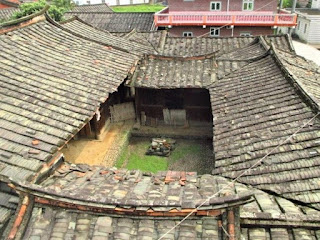











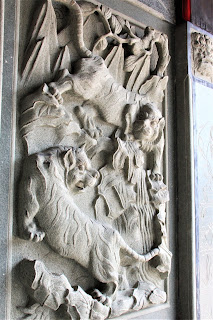




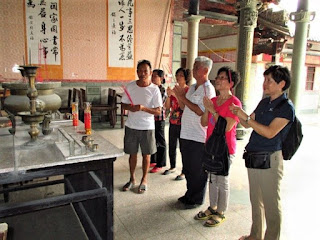
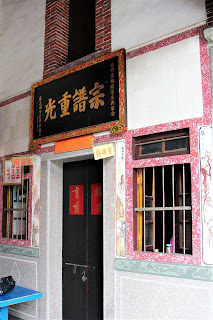



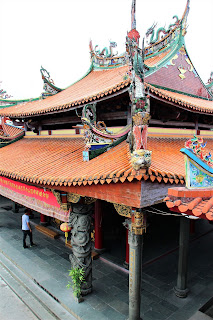













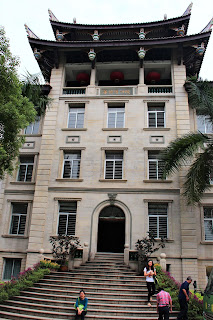
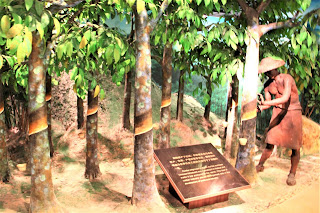















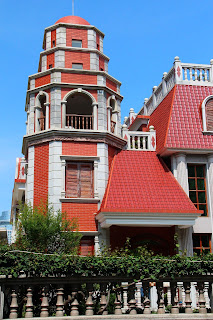































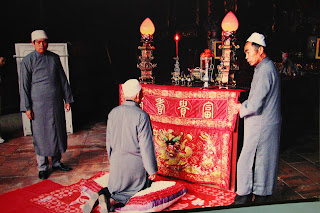






















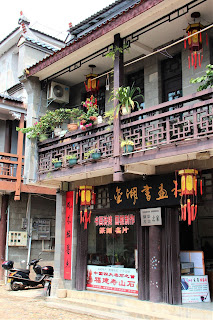












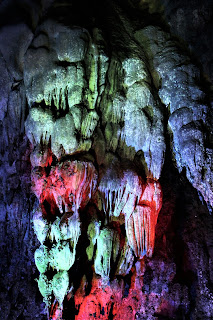





No comments:
Post a Comment